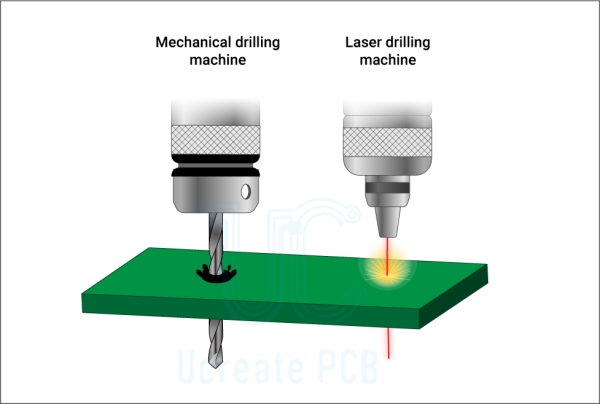Categories
Recent Posts
The hole in the PCB board is the key part of connecting the circuit wiring, and the hole diameter, position and hole density have a direct impact on the circuit performance. How to drill holes with good quality has always been one of the difficulties in PCB production. PCB manufacturers use different drilling methods to meet different PCB processing needs.
1. Laser Drilling:
Laser drilling has emerged as a groundbreaking technology in the PCB manufacturing industry. By utilizing high-intensity laser beams, it enables precise and rapid drilling of micro-vias and through-holes on PCBs. Here are some key features and benefits of laser drilling:
1.1 Unparalleled Precision:
Laser drilling offers unparalleled precision, allowing for extremely small hole sizes and positioning accuracy. This precision is particularly crucial in modern PCBs, which demand higher circuit density and miniaturization.
1.2 Versatility in Drilling:
With the ability to drill holes of varying shapes and sizes, laser drilling provides unparalleled versatility. It is especially advantageous for drilling blind and buried vias, which are essential for multilayer PCBs.
1.3 Minimal Heat and Mechanical Stress:
Laser drilling minimizes heat and mechanical stress on the PCB surface, ensuring reduced material damage, better hole quality, and increased yield rates. This is especially crucial for delicate substrates and high-density boards.
1.4 Faster Production Speed:
The speed of laser drilling surpasses that of traditional mechanical drilling methods. This efficiency translates to faster production cycles and improved overall productivity.

2. Harnessing the Power of Mechanical Drilling:
Mechanical drilling, a traditional method in PCB manufacturing, has been refined over the years to maintain its relevance in the industry. It involves the use of rotating drill bits to remove material and create holes. Here are some key features and benefits of mechanical drilling:
2.1 Cost-Effectiveness:
Mechanical drilling remains a cost-effective solution for many PCB manufacturers, especially for simpler designs and larger hole sizes. The equipment and tooling costs are generally lower compared to laser drilling.
2.2 Suitable for Thicker Substrates:
Mechanical drilling excels in drilling holes in thicker substrates, where laser drilling may encounter limitations. It offers robust performance and reliability in such scenarios.
2.3 Enhanced Flexibility:
Mechanical drilling allows for greater flexibility in terms of hole types and sizes, making it suitable for a wide range of applications. It can handle diverse materials and is compatible with various board thicknesses.
2.4 Repair and Rework Capabilities:
Mechanical drilling facilitates easier repair and rework processes. It provides more straightforward access to damaged or faulty areas, allowing for efficient fixes and minimizing production downtime.
3. Market Trends and Future Prospects:
The PCB drilling landscape is constantly evolving, driven by advancements in technology and market demands. Here are some notable trends and future prospects:
3.1 Integration of Laser and Mechanical Drilling:
As the industry continues to evolve, a hybrid approach that integrates laser and mechanical drilling is gaining traction. Manufacturers are leveraging the strengths of both methods to achieve optimal results and flexibility in their production processes.
3.2 Growing Demand for Miniaturization:
With the ever-increasing demand for smaller and more intricate electronic devices, the need for precise and reliable PCB drilling methods becomes critical. Laser drilling, with its exceptional precision and smaller hole sizes, is poised to meet this demand effectively.
3.3 Advancements in Laser Technology:
The field of laser drilling is witnessing continuous advancements, such as the development of ultrashort pulse lasers and beam shaping techniques. These innovations aim to enhance drilling capabilities, increase process efficiency, and reduce costs, further cementing laser drilling's position as a cutting-edge solution.
3.4 Sustainability and Environmental Considerations:
As sustainability gains prominence across industries, PCB drilling processes are also under scrutiny. Both laser and mechanical drilling methods are exploring ways to reduce energy consumption, optimize material usage, and minimize waste generation, aligning with eco-friendly practices.
Conclusion:
The world of PCB drilling is a fascinating domain, where laser and mechanical drilling methods coexist, each offering unique advantages. Laser drilling shines in terms of precision, versatility, and speed, while mechanical drilling excels in cost-effectiveness, flexibility, and repair capabilities. As the industry moves forward, the integration of these methods and ongoing technological advancements promise a future of enhanced precision, efficiency, and sustainability. By embracing these innovations, Ucreate PCB manufacturer stay at the forefront of the ever-evolving electronics industry.
Send Your Inquiry to Sales@ucreatepcb.com, we will quote you in 2 hours!